Innovative Charged Particle Energy Analyzers
In 2004, Goembel Instruments obtained a patent for it large geometric factor charged particle spectrometer. The invention enables the construction of high energy-resolution, large geometric factor charged particle energy analyzers. Immediate, practical aerospace applications for the invention include the measurement of electrostatic charge on spacecraft and the monitoring of the solar wind.
History
Founder Luke Goembel learned how to design and build charged particle energy analyzers while a Ph.D. candidate in the Johns Hopkins University Department of Chemistry.
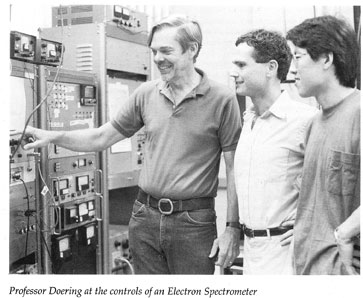
Dr. Goembel can be seen in the above photograph from a Johns Hopkins University Department of Chemistry Graduate School brochure (Goembel is second from the left, photograph taken about 1988). His mentor at Hopkins was Professor Doering.
Professor John P. Doering joined the faculty of the Johns Hopkins University in 1964. He was a professor of chemistry who specialized in experimental physical chemistry – he was an electron spectroscopist. He built spectrometers for experimental research on collisions of electrons with gas phase atoms and molecules. The experiments were done to better understanding of collision phenomena both for their own sake as well as for their relevance to the processes that take place in the atmospheres of planets and stars.
Professor Doering designed most of his spectrometers based on the work done by Simpson and Kuyatt at the National Bureau of Standards in the 1960s. Simpson and Kuyatt’s instruments, and Doerings, were able to collect very high quality spectra. They could collect very high quality spectra because their instruments had very high energy-resolution. Energy resolution in charged particle spectroscopy is analogous to resolution in photography: with better resolution one can see more detail.
Although Doering spent much of his career doing precise laboratory measurements with spectrometers he also designed a series of electron spectrometers for flight on rockets and satellites. After designing, building and flying a series of electron spectrometers for rockets in the 1960s, Professor Doering designed an electron spectrometer for NASA in the 1970s. His spectrometer, the Photoelectron Spectrometer Experiment (PES), flew on three satellites.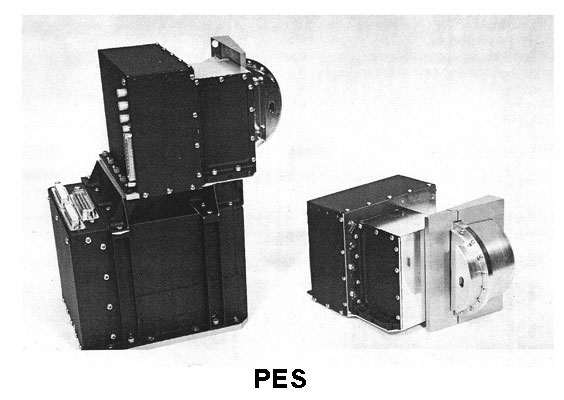
Unlike other instruments that had been flown, Doering’s spectrometers were very high energy-resolution (2.5%). They were also designed to look at low energy electrons (from 1 eV to 500 eV).
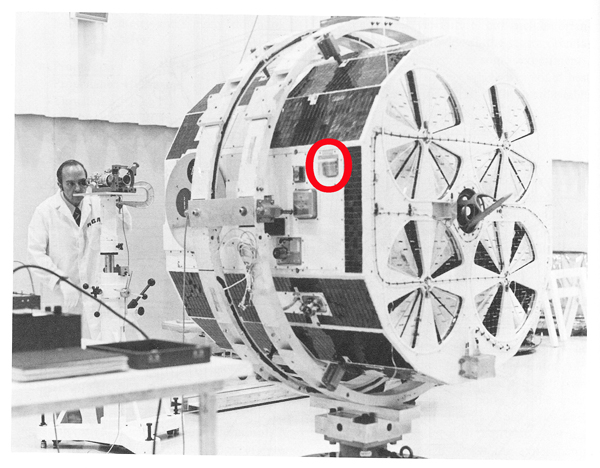
The PES spectrometer as it was mounted on the first of three satellites if flew on is shown circled in red, above. Although the PES instruments returned data of great value to researchers, they were the last instruments Doering built for space. Doering focused on laboratory, rather than space-based, spectroscopy until his death in 2010.
While Goembel was Professor Doering’s graduate student, from 1987 to 1992, then a post-doctoral fellow for one year after graduating, Goembel focused his efforts on the laboratory experiments and had little exposure to, nor interest in, Doering’s past space efforts. After Goembel won a National Academy of Sciences National Research Council Postdoctoral Fellowship to study at NASA Goddard Space Flight Center in 1993, Doering introduced Goembel to the work done by his PES instrument.
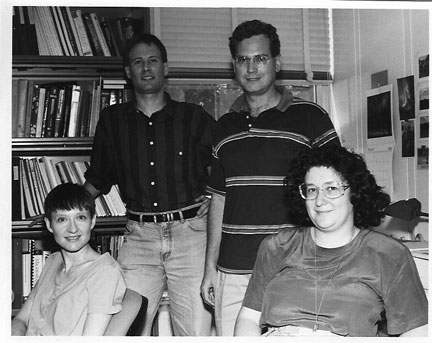
The photo, above, shows (left to right) Drs. Moses, Lehmacher, Goembel, and Kuznetsova all NRC Postdoctoral Fellows at NASA's Laboratory for Extraterrestrial Physics in 1994.
After Goembel started working at NASA, Dr. Doering revealed his disappointment with the charged particle energy analyzers that were being built by NASA and others. He conveyed that the instruments flown generally had poor energy-resolution and were not able to gather low-energy spectra. It was clear that this was not only due to the fashion in flight hardware to gather a lot of low resolution data quickly with survey instruments, but was also likely due to a lack of skill on the part of the instrument designers. Goembel became aware of the niche that could be filled by low energy, high energy-resolution devices. Prof. Doering also warned him that there was only a small group of designers of charged particle energy analyzers and that they were very competitive and effective at protecting their dominance of the field, regardless of the relative merit of the instruments they design. In the peer review process competitors with a vested interest in maintaining the status quo decide if funds will be awarded to newcomers in the field.
Goembel won a Postdoctoral Appointment at the Space Department of the Johns Hopkins University Applied Physics Laboratory (APL) in 1994 and left his Fellowship at NASA at that time. Throughout his time as a postdoc at NASA and APL he continued his collaboration with Doering and pondered the state of spectrometer design in the space sciences. When his postdoc at APL ended in 1997, he founded Goembel Instruments in order to build high performance charged particle energy analyzers for space science applications. Goembel and Doering collaborated until early 2002.
Vocabulary
Unfortunately, understanding the innovations of Goembel Instruments requires some understanding of charged particle energy analyzer theory and practice. The field is obscure and the vocabulary used by those practiced in the art is also obscure. The following is an introduction to the specialized vocabulary needed to understand the Goembel innovations.
Extraordinary energy resolution and geometric factor are enabled by Geombel Instruments technology. The geometric factor and energy resolution of a charged particle energy analyzer is analogous to the light gathering power and resolving power of an optical telescope. Energy resolution and geometric factor are fundamental performance metrics for charged particle energy analyzers, as will now be described.
Energy Resolution
At least in laboratory studies, energy resolution is usually highly valued. The detail revealed by such instruments allows scientific discoveries to be made. It is an oddity that when it comes to space-borne instrumentation, high energy-resolution instruments are generally not flown. The current lack of high energy resolution instruments for space research may have occurred because during the space race of the 1950s and 1960s there was a push to fly survey-type instruments. Survey-type instruments were designed to gather spectra from many directions very quickly and energy resolution was sacrificed for spatial resolution and speed. Such low-resolution instruments were practical when very little was known about the distribution of charged particle in space. In fact, the flight of the PES instrument in the 1970s, a space borne electron energy analyzer with abnormally high energy-resolution, can be considered an anomaly. PES was built by a skilled builder of laboratory instruments, and PES, as crude as it was compared to the instruments that can be built with Goembel Instruments technology, may have marked the pinnacle of design for high energy-resolution instruments that have flown.
One fairly recent and well-documented attempt to make a high energy-resolution charged particle energy analyzer for space is given as an example. The IBS instrument on Cassini was designed to have 1.3% energy resolution. The best the instrument builders could achieve when the instrument was completed was 2.0%. Higher (superior) energy-resolution is signified by a smaller number (e.g. 1.3% energy resolution is superior to 2.0% energy resolution). Other details in the design published for the IBS instrument indicate that the designers are ignorant of some basic spectrometer design guidelines Goembel learned while working with Professor Doering. Instruments such as IBS will be compared to those that can be built with Goembel Instruments technology will be detailed latter in this discussion.
Difficulty in designing and building high energy-resolution devices may be one reason lower energy resolution devices are flown. 5%, 10%, or even 40% energy resolution devices appear to be the norm. However, there are compelling reasons to build, and fly, high energy-resolution charged particle analyzers.
Superior energy resolution not only helps separate closely spaced peaks in a charged particle energy spectrum, it aids in the detection of weak sources of discrete energies when superimposed on a broad continuum by enabling the emergence of a tall peak above the statistical noise of the continuum. An advantage of high energy-resolution is illustrated below.
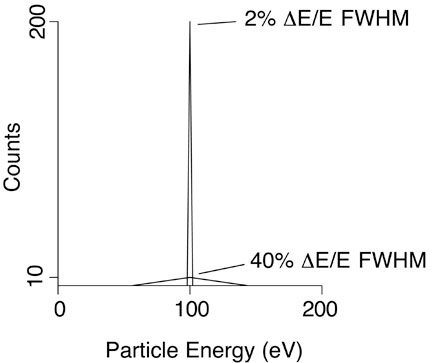
In the two superimposed hypothetical spectra shown, all of the fundamental properties of the spectrometer except energy resolution are held constant. A triangular instrument function has been chosen for this example. The peak for 100 eV particles gathered with 2% ΔE/E full width at half maximum (FWHM) energy resolution measures 2 eV across at half its height. For the same flux of charged particles and the same dwell time at each energy bin, the 40% energy resolution peak measures 40 eV across at half its height. The 40% energy resolution peak has a height of 10 counts and the 2% resolution peak has a height of 200 counts. In practice, a spectral feature that is easily seen in the spectrum from the 2% resolution instrument might be obscured by statistical noise in a spectrum from the 40% resolution instrument.
As a historical example of the benefit of higher energy resolution, the 2.5% energy resolution of PES enabled the collection of the first spectra that showed structure in the photoelectron energy distribution in the daytime ionosphere at between 20 and 30 eV. Lower energy resolution instruments would not have revealed such structure. It is hard to imagine circumstances where higher energy resolution would not be desired over lower energy resolution. So why don’t all charged particle energy analyzers have high energy-resolution? Higher energy resolution comes at a cost. Not only are such devices more difficult to design and build, there is generally a trade-off between energy resolution and geometric factor, as will be discussed below.
Geometric Factor
Besides being considered difficult to design, high energy-resolution spectrometers are also considered slow at gathering data compared to low energy-resolution spectrometers. In order to understand why, the concept of geometric factor is introduced. Geometric factor is analogous to the light gather power (or light grasp) of a telescope. Larger telescope objectives are able to gather more light, produce superior images, and enable advances in our understanding of the universe. Larger geometric factor charged particle energy analyzers can likewise produce superior spectra and enable advances in our understanding of the universe.
Geometric factor is the other key performance metric for charged particle energy analyzers. If one assumes the detection efficiency for a class of instruments (e.g., the class of channel electron multiplier equipped instruments) is the same, geometric factors can be compared to determine which instrument in that class will be more sensitive to a given particle flux (a measure analogous to light source ‘brightness’ for telescopes). Instruments with a larger geometric factor will be able to collect spectra more rapidly. Increased geometric factor can be an enabling technology for certain studies. Increased geometric factor allows the collection of spectra with better-defined features, or, alternatively, the collection of useful data over more energy, spatial, or temporal bins.
The geometric factor of a charged particle energy analyzer gives the ‘particle gathering power’ of the device. It is a product of the instrument’s field of view and its entrance aperture area, as illustrated below.
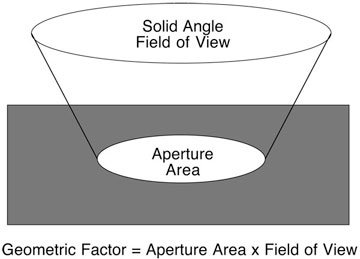
A trade-off between a charged particle spectrometer’s energy resolution and its geometric factor may arise due to the common practice of reducing slit width (and area) to increase energy resolution. Geometric factor is thereby reduced when resolution is increased. The features of interest in a charged particle spectrum may be easier to discern above the background if resolution is increased, but it may then take too long to gather a spectrum due to the reduced geometric factor. Long accumulation times are especially problematic in the dynamic, low particle flux environment of space.
Goembel Instruments Innovation
The 180˚ spherical sector curved plate electrostatic charged particle energy analyzer (“hemispherical analyzer”) has been deployed in space since at least the 1960s. Hemispherical analyzers are also used for high energy-resolution work in the laboratory due to their high particle throughput ‘focusing’ charged particle optics. Traditionally, the aperture for a hemispherical analyzer has been circular, as it was for PES. The following illustrates how the aperture area of a hemispherical analyzer can be increased without increasing the slit width.
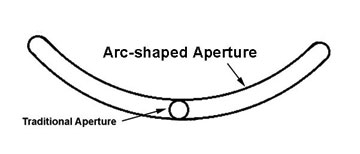
It has been shown in practice that using a curved aperture and collimator arrangement increases the aperture area without a decrease in energy resolution. Although curved apertures have been used for decades in laboratory instruments and on at least one space-borne instrument none have benefited from the unique curved collimator/aperture arrangement that has been invented by Dr. Goembel. The large geometric factor charged particle spectrometer is a Goembel Instruments patented technology that has been proven to provide extraordinary performance (e.g. extraordinary geometric factor at high energy resolution) in the laboratory.
An example of a spectrum from an instrument based on the patented design (the Goembel Instruments SCM) is given below, along with Professor Doering’s assessment of the device.
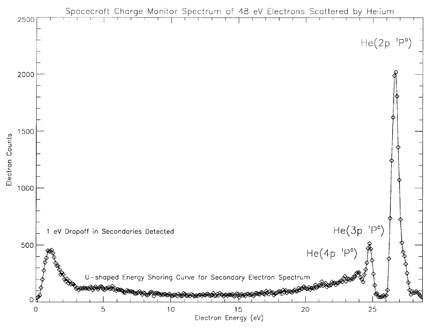
"The significance of the fact that the SCM can so clearly detect the Helium secondary electron spectrum cannot be overemphasized. Ionization of Helium by 48 eV electron impact is closely related to photoionziation. In fact, in the limit of zero momentum change in the ionizing collision ( an impossible point to achieve in electron impact since even if the incident electron is scattered at 0°, there is still a small momentum change due to the energy lost by the incident electron) electron impact ionization and photoionization are identical processes with identical cross sections. The energy spectrum of the secondary electrons in the figure is therefore closely related to the photoelectron energy distributions we will be measuring from the spacecraft. The results from the He measurement show conclusively that the SCM analyzer is free of undesirable effects such as electrons rejected by the analyzer that could show up as noise obscuring the real spectrum or electron optical effects which could make the sensitivity of the analyzer different at different energies." [Professor John P. Doering, March 27, 2002.]
Prof. Doering was hired as a consultant during the testing of the prototype SCM sensor head. The prototype sensor head that collected the spectrum is shown below.
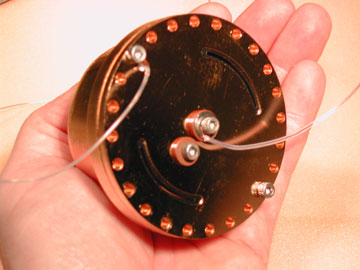
Based on a 20-fold increase in aperture area and a 3-fold increase in field of view, the SCM has 60-fold the geometric factor of its predecessor, the PES instrument. At the same time, it has even better energy resolution: 2.0% instead of 2.5%. Perhaps most important to the application of the invention to space hardware, the SCM sensor head diameter (the size of the hemisphere required) is smaller than that of the PES hemispherical analyzer. In summary the invention allows significantly increased performance (both geometric factor and energy resolution) and/or miniaturization. To make the analogy to light gathering telescopes again, it is as if a massive world-class research telescope could now be built the size of a portable, amateur telescope (as illustrated below).
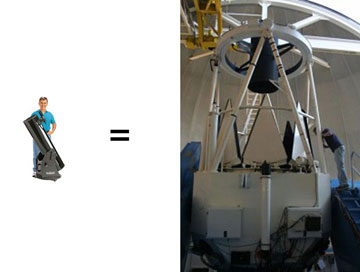
Comparison of SCM to Other Charged Particle Energy Analyzers
The table below displays instrument weight, normalized geometric factor, and normalized energy resolution for four flight-ready charged particle energy analyzers. A normalized performance metric appears, as does a normalized performance metric per unit mass. All of the instruments except the Goembel Instruments SCM have been deployed on spacecraft.
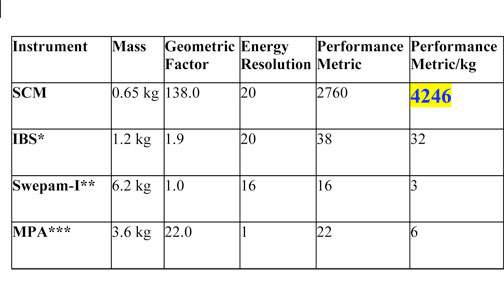
In a comparison of geometric factor, the Goembel Instruments SCM is multiples, even orders of magnitude better than charged particle energy analyzers now flown. And the SCM weighs significantly less than any of the charged particle energy analyzers listed.
Although apparently ignored by those who choose what instruments fly (or by those who are chosen to build instruments for missions), energy resolution is a fundamental component of instrument performance. If one were to use one number to compare the performance of the instruments listed in the table, one could multiply the normalized geometric factor by the normalized energy resolution to obtain a normalized performance metric. This seems a fair way to compare spectrometers since, at least for spherical sector analyzers, doubling slit width doubles geometric factor and halves energy resolution.
A final column has been added to the table to highlight that since we are comparing flight instruments, the mass of the instrument cannot be ignored. The completed, flight-ready SCM, at 0.65 kg is by far the lightest of the instruments. Performance metric normalized to instrument mass appears in the final column. From the highlighted number “4246” in the table one can see that the Goembel Instruments SCM, a device that is built and ready to fly today, is has two orders of magnitude better performance per unit mass than its nearest competitor (which rates a “32”) and has three orders of magnitude better performance per unit mass than its weakest competitor.
References and Further Reading
The references listed below are for the instruments listed in the table. Supporting references for this webpage are available upon request.
*Ion Beam Spectrometer (IBS) of the Cassini plasma spectrometer instrument aboard the Cassini/Huygens spacecraft. Vilppola, J. H.; Tanskanen, P. J.; Barraclough, B. L.; McComas, D. J.; Comparison between simulations and calibrations of a high resolution electrostatic analyzer, Review of Scientific Instruments, Vol 72, No 9, pp.3662-3669, 2001.
**The Solar Wind Electron Proton Alpha Monitor (SWEPAM) instrument on the ACE spacecraft. McComas, D.J. , S.J. Bame, P. Barker, W.C. Feldman, J.L. Phillips, P. Riley and J.W. Griffee Solar Wind Electron Proton Alpha Monitor (SWEPAM) for the Advanced Composition Explorer, Space Science Reviews, v. 86, Issue 1/4, p. 563-612 (1998).
***The Los Alamos Magnetospheric Plasma Analyzer (MPA). McComas, D. J., “Magnetospheric Plasma Analyzer (MPA): Plasma observations from geosynchronous orbit”, Presented at the 10th Taos Workshop on the Earth's Trapped Particle Environment, Taos, NM, Aug. 1994. And Borovsky, J.E., and McComas, D.J., Calculation of Moments from Measurements by the Los Alamos Magnetospheric Plasma Analyzer, Los Alamos National Lab Technical Report LA_135666-MS, 1999.
